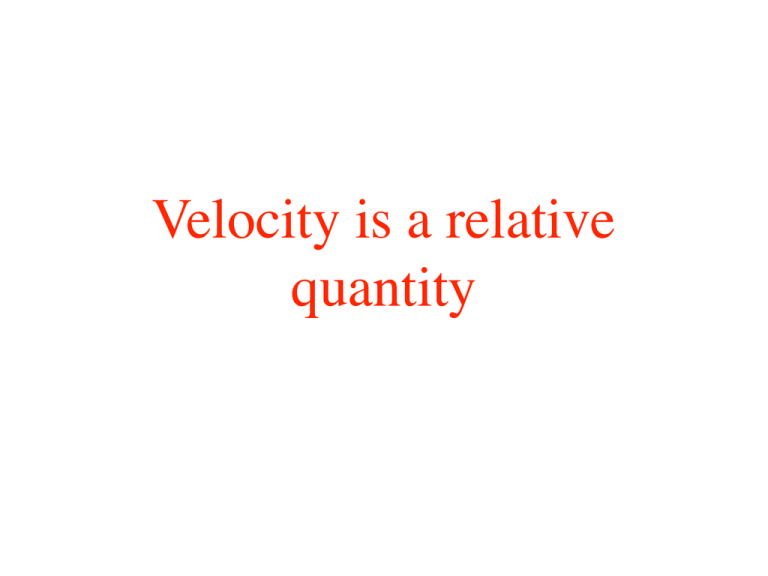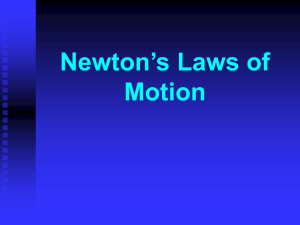Velocity is a relative quantity
advertisement

Velocity is a relative quantity Disentangling Coordinates PHY2053, Fall 2013, Lecture 6 – Newton’s Laws 2 Reference Frames y • Consider two frames of reference the O-frame (label events according to t,x,y,z) and the O'-frame (label Vt' events according to t',x',y',z') moving at a constant velocity V, with respect to each other at let the origins O coincide at t= t' = 0. In the Galilean transformations the O and O' frames are related as follows: z' z t = t! Δt = t 2 − t1 = Δt ! = t 2! − t1! x = x ! + Vt ! Δx = x2 − x1 = x2! − x1! + V (t 2! − t1! ) = Δx! + VΔt ! Time is absolute! y = y! z = z! Δy = Δy ! Δz = Δz ! y' V Event O: (t,x,y,z) O': (t'.x',y',z') x' x O' x x' Classical velocity addition formula! • Galilean Velocity Transformation: Δx Δ x ' Δt ' Δx ' vx = = +V = + V = v!x + V Δt Δt Δt Δt ' Δy Δy ' Δy ' vy = = = = v!y Δt Δt Δt ' Δz Δz ' Δ z ' vz = = = = v!z Δt Δt Δt ' R. Field 9/6/2012 University FloridaLecture PHY2053, Fallof2013, PHY 2053 6 – Newton’s Laws Page 8 3 Postulates of Classical Physics y • First Postulate of Classical Physics (“Relativity Principle”): y' V The basic laws of physics are identical in all systems of reference (frames) which move with uniform (unaccelerated) velocity with respect to one another. The laws of physics are invariant under a change of inertial frame. The laws of physics have the same form in all inertial frames. It is impossible to detect uniform motion. Vt' Event O: (t,x,y,z) O': (t'.x',y',z') x' x O O' x z x' z' • Second Postulate of Classical Physics (Galilean Transformation): The O and O' frame are related by the Galilean Transformation. t = t! x = x! + Vt ! y = y! Δt = Δt ! Δx = Δx ! + VΔt ! Δy = Δy ! z = z! Δz = Δz ! R. Field 9/6/2012 University FloridaLecture PHY2053, Fallof2013, PHY 2053 6 – Newton’s Laws Classical velocity addition formula! v x = v!x + V v y = v!y v z = v!z Page 9 4 H-ITT Problem #1, 3 min Relative Velocity 5 • 1) 2) 3) 4) 5) see H-ITT Problem #1, 3 min Car A is driving 45 mph south. Car B is driving 60 mph at 45º west of south. What is the magnitude and direction of the velocity of car A as seen by a passenger in car B? Direction is expressed in angle with respect to East. vBA ≃ 115 mph, direction ≃ 50º vBA ≃ 115 mph, direction ≃ 25º vBA ≃ 100 mph, direction ≃ 50º vBA = 100 mph, direction ≃ 25º vBA = 85 mph, direction ≃ 50 ✖ ✖ ✖ ✖ ✖ No valid solution is listed. See following slides. PHY2053, Lecture 6, Newton’s Laws 6 The problem is asking us to compute the magnitude and direction of a vector. We know how to calculate these quantities if we know the x and y components of a vector: q ~ = ax x̂ + ay ŷ A ~ = |A| a2x + a2y ; tan ✓ = This means that breaking the calculation up by x and y components will simplify solving the problem. Broken up into x and y components, the two velocity vectors are: ay ax ~vA = [ 45 ŷ] mph ~vB = [( 60 sin ↵)x̂ + ( 60 cos ↵)ŷ] mph What vector calculation do we want to perform? We know the velocities of both cars with respect to the ground. It then makes sense to take the reference frame fixed to the ground to be the reference frame “from” which we are transforming (O). We want to know what an observer in car “B” would see. So, the reference frame of car “B” should be the reference frame “into” which we are transforming (O’). We defined the velocity vector V as the velocity with which reference frame O’ [car B] is moving when observed from reference frame O[the ground], in other words, . The relevant velocity transformation formula is: ~ V = ~vB PHY2053, Lecture 6, Newton’s Laws 0 ~vA = ~vA ~ V h ~ , compute Given ~vA and V 0 ~vA . i 7 Having broken down the velocities of car A and car B, we now do the calculation of va’ by components: 0 ~ = ~vA ~vB ~vA = ~vA V = [( 45 ŷ) [( 60 sin ↵)x̂ + ( 60 cos ↵)ŷ]] mph = [ 45 ŷ + 60 sin ↵ x̂ + 60 cos ↵ ŷ] mph = [42.43 x̂ + (42.43 = [42.43 x̂ 45) ŷ] mph 2.57 ŷ] mph. The magnitude of the velocity with which an observer in car B sees car A moving (vA’) is 0 vA = = = = 0 |~vA | hq i 2 2 vA,x + vA,y hp i 42.432 + 2.572 mph 42.51 mph The direction angle can be computed from 0 vA,y tan ✓ = 0 vA,x ! ✓ = tan 1 = tan 1 PHY2053, Lecture 6, Newton’s Laws ⇣ 0 vA,y 0 vA,x ⌘ = tan ( 6.06) = 1 ⇣ 2.57 mph 42.43 mph 6.05 rad = ⌘ 3.47 8 PHY2053, LECTURE 6: Newton’s Laws PHY2053, Fall 2013, Lecture 6 – Newton’s Laws Newton’s First Law Law 1: Objects in motion tend to stay in motion, and objects at rest tend to stay at rest unless an outside force acts upon them. Note - “motion” in this translation implies “motion with a constant velocity along a straight line” PHY2053, Fall 2013, Lecture 6 – Newton’s Laws Experiment Inertial ball Newton’s Second Law Law 2: The rate of change of the LAW II:Mutationem The alteration of Lex II: motus momentum of a body is directly motion is ever proportional to proportionalem esse vi motrici proportional to the net force the motive force impress’d, and impressae, fierithe secundum acting on it,etand direction of is maderectam in the direction of the lineam qua vis illa the change in momentum takes right line in which that force is imprimitur. place in the direction of the net impress’d. (translation by Motte, 1792) force PHY2053, Fall 2013, Lecture 6 – Newton’s Laws Net force ● Force is a vector quantity “Net Force”: ● For systems with constant mass, the rate of change of momentum is , so 2nd Newton’s law becomes: ● Mass [inertial] m is a proportionality constant between force and acceleration → the property of an object to resist velocity changes PHY2053, Fall 2013, Lecture 6 – Newton’s Laws Four Fundamental Forces ● Electromagnetic Force ● electricity, magnetism, atoms, light ● Gravitational Force ● planets, galaxies ● Weak Force ● nuclear decay - keeps the stars “burning” ● Strong Force ● proton, neutron PHY2053, Fall 2013, Lecture 6 – Newton’s Laws Normal Force ● ● ● ● Not a fundamental force Due to atomic structure of every-day objects Objects resist other objects trying to enter their volume Counter-examples: radiation, (exotic) particles ● Model with a perfectly rigid, impenetrable surface ● Surface exactly counters normal component of contact force exerted on it by an object ● Example: You are sitting / standing / not falling through the floor to the center of the Earth right now PHY2053, Fall 2013, Lecture 6 – Newton’s Laws Normal Force Example: Incline The angle of the frictionless incline is α = 30°. Mass m1 slides down the incline, starting from rest. What is the speed of the mass after it slid 10 meters downhill? [use g = 10 m/s2] PHY2053, Fall 2013, Lecture 6 – Newton’s Laws




